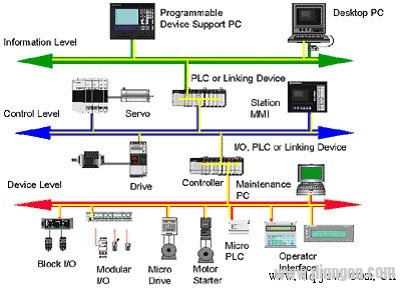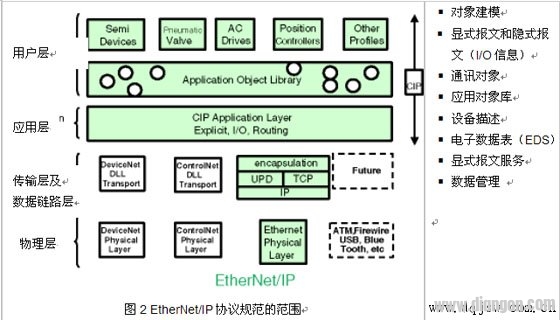DeviceNetâ„¢ and ControlNetâ„¢ are well-known industrial networks developed by ODVA (Open DeviceNet Suppliers Association) and ControlNet International, two major industry organizations. These networks use the CIP (Common Industrial Protocol) at the application layer. Recently, ODVA and ControlNet International introduced EtherNet/IP, a standard industrial Ethernet protocol that extends the capabilities of traditional industrial networks. This article explores the technical principles and transport mechanisms of EtherNet/IP, explaining how it ensures consistency in network services and data objects over Ethernet using TCP/UDP/IP.
I. Introduction In industrial automation systems, the network must support three core services: control, configuration, and data acquisition. Control is the most critical feature, enabling real-time communication between devices like PLCs and I/O modules such as sensors and actuators. To ensure timely data exchange, these systems require high-priority transmission or interrupt handling. Configuration services allow users to set up and maintain equipment, often through PCs, even while the system is running. Data acquisition involves collecting operational data for monitoring, analysis, and diagnostics, which helps improve system performance and efficiency. The producer/consumer communication model is more suitable for supporting these services compared to the source/target model. By leveraging distributed objects and this model, automation systems can better meet their functional requirements. As shown in Figure 1, a typical industrial automation system consists of multiple layers, including the information layer (Ethernet), control layer (e.g., ControlNet), and device layer (e.g., DeviceNet). Each layer has different physical and data link layer characteristics, so a multi-layer architecture is necessary to ensure seamless data exchange across networks.

When implementing control, configuration, and data collection on Ethernet, other network services like HTTP for web browsing may also run on the same network. The producer/consumer model must coexist with these services, ensuring efficient operation without conflicts. EtherNet/IP, developed by ODVA and ControlNet International, supports all three services over Ethernet. It can function as both an information and control layer network, offering flexibility and scalability for modern industrial applications.
II. Implementation of CIP Protocol on Ethernet EtherNet/IP is structured into several chapters and appendices, with the main content illustrated in Figure 2. As shown, EtherNet/IP, DeviceNet, and ControlNet share a unified application layer, object library, and device description. In the OSI model, they operate primarily at the lower four layers. This architecture enables optimized control, configuration, and data acquisition, making EtherNet/IP more practical and reliable in industrial settings.

III. Coexistence with Other Internet Protocols One of the key advantages of EtherNet/IP is its ability to leverage existing Ethernet infrastructure and knowledge, maximizing return on investment. With many vendors offering Ethernet equipment, the cost of building a network is significantly reduced. Users can take advantage of available network devices to manage costs effectively. However, if EtherNet/IP requires a specific vendor’s physical medium or dedicated environment, its benefits diminish. Therefore, EtherNet/IP must coexist with existing Internet and intranet protocols, particularly TCP/IP. This allows seamless integration with enterprise networks and ensures compatibility with various applications.
A. Ethernet Communication Protocol Ethernet defines the physical medium and access method (CSMA/CD), using a simple frame format for LAN communication. While it lacks advanced features for full LAN functionality, it supports upper-layer protocols like TCP/IP for data transmission and network management. These protocols determine the network's capabilities, device connectivity, and interoperability. TCP/IP has become the dominant protocol in industrial environments due to its global connectivity and enterprise integration capabilities. It operates at the application layer, while IP and TCP/UDP handle the network and transport layers respectively. This structure enables efficient and scalable communication across diverse industrial systems.
B. Origin and Characteristics of the TCP/IP Protocol TCP/IP has been widely adopted across computer platforms, integrated into operating systems like Windows NT and Windows 2000. It enables devices from different manufacturers to communicate seamlessly within a LAN. The protocol follows a layered structure, matching the OSI model. IP handles the network layer, while TCP/UDP manages the transport layer. The IP protocol sends packets in a connectionless manner, relying on the transport layer for reliability. ARP maps IP addresses to Ethernet addresses, facilitating local communication. IP addresses are assigned by InterNIC and must be unique within a network. They can be configured by users, but careful planning is needed to avoid conflicts. IPv6 is being developed to address the growing demand for IP addresses.
C. Application Layer Protocols and Interoperability While TCP/IP ensures basic communication, application layer protocols like FTP, HTTP, and SNMP define how data is exchanged. RFC documents provide detailed specifications, allowing manufacturers to develop compatible devices. However, in industrial automation, interoperability remains a challenge. Devices from different vendors may use varying application layer protocols, preventing seamless communication. EtherNet/IP solves this issue by supporting coexistence with existing protocols, running on top of TCP/UDP. This makes it a versatile solution for integrating devices from multiple vendors into a single, efficient network system.
Single Phase Ammeter,Energy Meter,Digital Energy Monitor,Led Ammeter
zhejiangjinyidianqiyouxiangongsi , https://www.jooeei.com